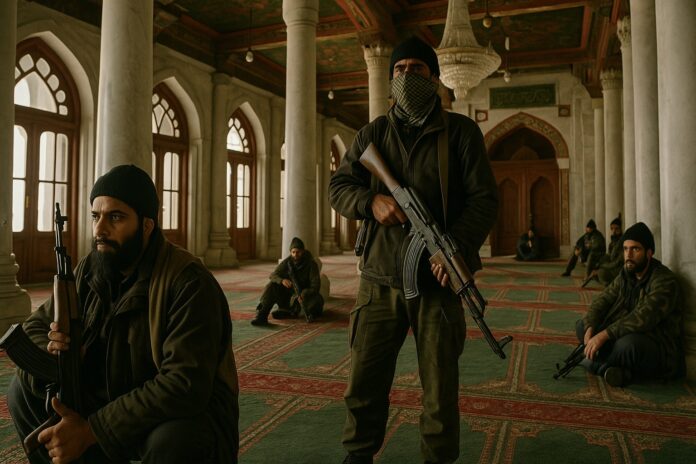The Hazratbal tactic was not random — it fit Pakistan-backed groups’ playbook of stoking communal anger. When armed men took positions inside Srinagar’s Hazratbal shrine in October 1993, TV crews and crowds gathered on the lakefront. The scene looked like a military standoff, but it was also a stage. The goal was not only to survive behind sacred walls. It was to turn faith into optics and make India look like the violator, no matter what the state did next. Through the 1990s, Pakistan-linked outfits such as Hizbul Mujahideen (HM) and the Al-Umar Mujahideen shaped the conflict’s script. HM is widely documented as Pakistan-based and has long argued for Kashmir’s merger with Pakistan. Al-Umar, founded by Mushtaq Zargar in 1989, operated in Srinagar’s old city at the height of street-level militancy. Their presence defined the era’s tone and tactics. Holy places became tools. Militants understood that shrines and mosques draw deep emotion and large crowds.
If they occupied a sacred site, authorities faced a trap. Storming it risked outrage and waiting invited taunts of weakness. Hazratbal in 1993 showed this clearly. The government ring-fenced the complex and negotiated. The men later walked out without weapons, and the shrine was not harmed. Yet the weeks of siege boosted the militants’ message and raised tempers across the Valley. The same playbook appeared again. In 1995, Hizbul commander Mast Gul and associates turned the Charar-e-Sharief shrine into another theatre. The 66-day standoff ended in a devastating fire that destroyed the 14th-century complex, leaving a heavy scar on the Valley’s memory. The episode underlined how militants tried to recast themselves as defenders of the shrine even as the site suffered. The tactic mattered because the wider conflict was framed as a “proxy war.”
Analysts and official studies through the late 1990s and early 2000s described Pakistan’s approach as one of cross-border support for militant groups with the aim of bleeding India and provoking communal polarisation. In that frame, occupying holy places promised maximum publicity at minimal military cost. It was designed to force scenes of curfew, grief and anger onto nightly news. And to tell the world that India could not keep order without hurting Muslim sentiment. Urban militancy adapted to this logic. Reports from the period show how city operations often shifted to quick strikes and symbolism rather than pitched battles. In that environment, religious sites offered protection from raids and a ready audience.
A siege could be stretched by rumor and spectacle, even if little fighting occurred. Security forces, for their part, worked to expose the tactic and avoid a religious flashpoint. During Hazratbal in 1993 they maintained an outer cordon and kept the military out of the sanctum. Public messaging stressed that the shrine’s safety came first. After the siege, government documents also recorded attempts by armed groups to force their way back into Hazratbal in 1996, including damage to locks near the relic vault — details used to argue that militants were weaponising sanctity, not protecting it. The human cost beyond the shrine was real. Protests linked to the Hazratbal siege turned deadly in places like Bijbehara on 22 October 1993, where security forces opened fire on marchers and dozens of civilians were killed.
Those deaths deepened the propaganda win for militants: they could point to fresh graves while claiming to stand for faith. By the end of the decade, the lesson was plain. Occupying shrines was not mainly about holding ground; it was about shaping the story. Groups like HM and Al-Umar sought a reaction that would feed grievance and headlines. Each siege, raid or curfew around a holy place became a test of control over public feeling.

